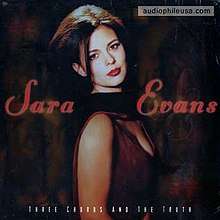Three Chords and the Truth (song)
"Three Chords and the Truth" is a song co-written and recorded by American country music artist Sara Evans. It was released in July 1997 as the second single from Evans' debut album of the same name in July 1997. Despite its minor success on the Billboard country chart, it was critically acclaimed for its retro-themed production. Since its release, "Three Chords and the Truth" has been identified with Evans' early career persona as a traditionally-oriented country music vocalist.
| "Three Chords and the Truth" | ||||
|---|---|---|---|---|
 | ||||
| Single by Sara Evans | ||||
| from the album Three Chords and the Truth | ||||
| B-side | "The Week the River Raged"[1] | |||
| Released | July 6, 1997 | |||
| Recorded | February 1997 Burbank, California, U.S.[1] | |||
| Genre | Country | |||
| Length | 3:59 | |||
| Label | RCA Nashville | |||
| Songwriter(s) |
| |||
| Producer(s) | Pete Anderson | |||
| Sara Evans singles chronology | ||||
| ||||
Content
"Three Chords and the Truth" was co-written by Sara Evans, Ron Harbin, and Aimee Mayo. The latter songwriter would later be a frequent collaborator with Evans.[2] The song's plot focuses on lost love and the narrator reconciling with her partner. The song references the famous description of country music by Harlan Howard. It was recorded at the Mag Dog Studio in Burbank, California, United States in February 1997. The song is one of the few tracks in Evans' career that has been recorded outside of Nashville, Tennessee.[1] It was produced by Pete Anderson, whose intention was to try to give the song (and the future album) a traditionally-themed production.[3]
Critical Reception
"Three Chords and the Truth" received praise and acclaim from various music critics. James Crispell of Allmusic called the track "a must for new country fans". Crispell also stated that Pete Anderson's production allowed Evans' voice an "opportunity to shine".[2] Kathy Coleman from About.com called the song "fantastic" and praised Evans' vocal styling, stating, "her conviction apparently obvious in every vocal phrasing, in every sentimental weeping tone. She is country, sweet and sincere; she is country, strong and sorrowful."[3] Daniel Cooper of New Country magazine was less favorable, citing it as an example of Evans' "fondness for abstraction", as he did not understand what "the truth" was referring to: "What truth? That her cheating heart will make her weep? That Rubber Duckie is the one?"[4]
Music video
The music video for "Three Chords and the Truth" was filmed in 1997 and was directed by Susan Johnson. It was the very first music video Evans would make. Johnson would also direct her next two releases; "I Don't Wanna See the Light" and "Cryin' Game".[5] The video depicts a retro-oriented theme, featuring Evans driving a 1964 Ford Galaxie 500 convertible and dressed in vintage attire.[6] The song's video was nominated for three awards by Country Music Television and from Billboard Magazine.[7] On CMT's televised list of the 100 Greatest Videos in 2008, "Three Chords and the Truth" was ranked at number seventy-one.[8]
Chart performance
"Three Chords and the Truth" was released on July 6, 1997 via RCA Nashville. It was the second single issued from Evans debut album of the same name. The song reached a peak of forty-four on the Billboard Hot Country Singles & Tracks chart, becoming only a minor hit. The song did however become Evans' highest-charting single from her debut album, as its other releases reached lower positions.[9] In an interview with BuzzFeed in 2014, Evans said that although the song did not gain major success, she learned a lot from the experience:[10]
"I learned a huge lesson in that: There's definitely an effort that needs to be made between being authentic and artsy and cool and who you are, yet being commercial. Having that commercial success. Because I wasn't gonna be satisfied with just the critical acclaim. I wanted it all. I wanted radio hits, because that had been my dream since I was a little girl. Partying and beer drinking and all that; it would have been so dishonest if I had tried to come out with a record like that just to be part of the trend."
| Chart (1997) | Peak position |
|---|---|
| US Hot Country Songs (Billboard)[11] | 44 |
Personnel
- Murray Adler – conductor
- Beth Andersen – background vocals
- Jimmy Bond – string arrangements
- Jim Christie – drums
- Kevin Dukes – acoustic guitar
- Sara Evans – lead vocals, background vocals
- Tommy Funderburk – background vocals
- Scott Joss – fiddle
- Jim Lauderdale – background vocals
- Dean Parks – acoustic guitar
- Doug Pettibone – electric guitar
- Taras Prodaniuk – bass guitar
- Joy Lynn White – background vocals
References
- "Sara Evans Discography". Praguefrank's Country Discographies. Retrieved 23 March 2014.
- "Three Chords and the Truth -- Overview". Allmusic. Retrieved 23 March 2014.
- Coleman, Kathy. "Sara Evans -- Three Chords and the Truth CD review". About.com. Retrieved 23 March 2014.
- Cooper, Daniel (July 1997). "Reviews: Sara Evans — Three Chords and the Truth". New Country. 4 (8): 56–57.
- "Sara Evans videography". Music Video Database. Retrieved 23 March 2014.
- "Album review: Three Chords and the Truth". My Kind of Country. Retrieved 23 March 2014.
- Dooley, Sean. "Sara Evans - Biography". About. Retrieved 23 March 2014.
- "CMT's 100 Greatest Videos". Country Music Television. Retrieved 23 March 2014.
- "Three Chords and the Truth -- Awards". Allmusic. Retrieved 23 March 2014.
- Shanker, Deena. "Sara Evans' New Album Refuses To Hop On The "Bro Country" Bandwagon". BuzzFeed. Retrieved 23 March 2014.
- "Sara Evans Chart History (Hot Country Songs)". Billboard.
- "Three Chords and the Truth -- Credits". Allmusic. Retrieved 23 March 2014.